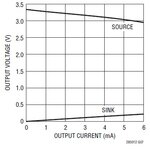jasensio1
Newbie level 6
Hello guys.
I've got a driver running at 3V and a receiver running at 3.3V.
According to datasheets, these are threshold values:
Driver: VOH 2.4V min (4 mA)
Receiver: VIH 2.5V max. Input max current 0.5 uA
First thought is that they are not compatible but, are variations between min, typical and max values for this parameters something that can be under control?
If I keep the output current much lower than 4 mA, can I expect in any case voltages close to 3V at driver output?
Many thanks
I've got a driver running at 3V and a receiver running at 3.3V.
According to datasheets, these are threshold values:
Driver: VOH 2.4V min (4 mA)
Receiver: VIH 2.5V max. Input max current 0.5 uA
First thought is that they are not compatible but, are variations between min, typical and max values for this parameters something that can be under control?
If I keep the output current much lower than 4 mA, can I expect in any case voltages close to 3V at driver output?
Many thanks
